Agriculture has long been a cornerstone of the Philippine economy, shaping its society and providing livelihoods for millions. Over the years, the introduction of American agricultural techniques has played a pivotal role in transforming farming practices across the country. These advancements have not only boosted productivity but also paved the way for more sustainable and efficient methods.
From modern irrigation systems to cutting-edge farming equipment, American innovations have significantly influenced the Philippines’ agricultural landscape. This integration of technology has helped farmers increase yields while reducing environmental impact. The collaboration between the two nations continues to drive progress, ensuring food security and economic growth.
As we explore the historical and contemporary impact of these techniques, it becomes clear how they have reshaped the agricultural sector. This article delves into the ways American advancements have contributed to the modernization of farming in the Philippines, highlighting their importance in today’s world.
Key Takeaways
- American agricultural techniques have transformed farming in the Philippines.
- Modern irrigation systems and equipment have boosted productivity.
- These innovations promote sustainability and efficiency.
- Collaboration between the U.S. and the Philippines drives agricultural progress.
- Agriculture remains a vital part of the Philippine economy and society.
Introduction to American Agricultural Influence in the Philippines
Modern techniques from the U.S. have reshaped farming practices in the Philippines. Over the years, traditional methods have evolved into advanced systems that prioritize efficiency and sustainability. This transformation has been driven by the integration of American innovations, particularly in crop management and food production.
One of the most significant changes has been the adoption of mechanized equipment. Tools like tractors and harvesters have replaced manual labor, increasing productivity and reducing costs. Additionally, modern irrigation systems have ensured consistent water supply, even during dry seasons. These advancements have not only improved yields but also minimized environmental impact.
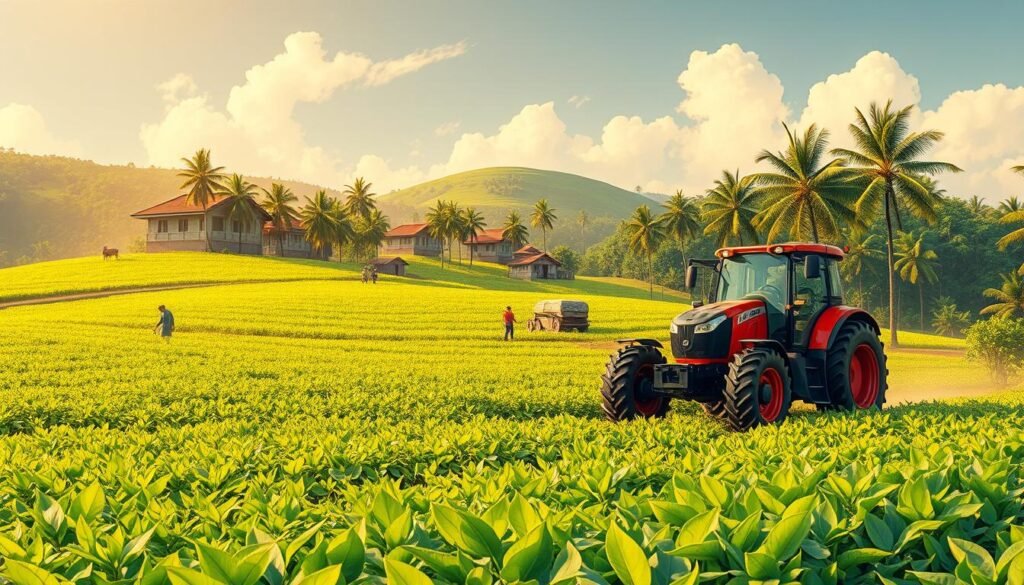
The shift toward sustainable practices has been another key benefit. Farmers are now using precision agriculture to optimize resource use. This includes monitoring soil health, applying fertilizers strategically, and reducing waste. Such methods have made food production more efficient while preserving natural resources.
Here’s a quick overview of the impact of American techniques on Philippine farming:
| Aspect | Traditional Methods | Modern Techniques |
|---|---|---|
| Labor | Manual | Mechanized |
| Irrigation | Rain-dependent | Controlled systems |
| Resource Use | High waste | Optimized |
| Yields | Low | High |
The integration of these practices has strengthened the agricultural sector, contributing to national development. By adopting American methods, the Philippines is ensuring food security and economic growth for future generations.
Historical Context of Farming in the Philippines
Farming in the Philippines has a deep-rooted history that reflects its cultural and economic evolution. Long before modern techniques arrived, indigenous communities practiced traditional methods that sustained their livelihoods. These early practices laid the foundation for the agricultural advancements seen today.
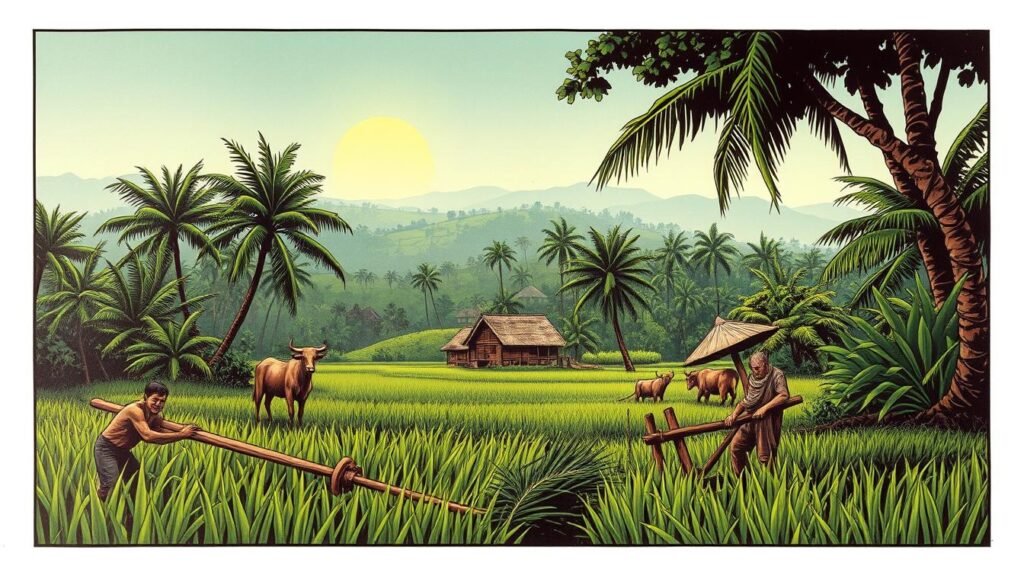
Pre-Colonial Farming Roots
Before colonization, farming in the Philippines was deeply tied to the land and its resources. Indigenous groups relied on sustainable practices like kaingin (slash-and-burn) and crop rotation. These methods ensured soil fertility and minimized waste.
Communities cultivated staple crops such as rice, corn, and root vegetables. They also practiced intercropping, growing multiple crops together to maximize space and resources. This approach showcased their deep understanding of the environment.
Colonial and Early Modern Influences
The arrival of Spanish colonizers in the 16th century brought significant change to farming practices. They introduced new crops like sugarcane, tobacco, and coffee, which became major exports. However, these changes often disrupted traditional systems.
During the American colonial period, farming saw further modernization. The establishment of the Insular Bureau of Agriculture in 1901 marked a turning point. American officials introduced mechanized tools and irrigation systems, setting the stage for future innovation.
Over time, these influences reshaped the agricultural landscape. The integration of foreign techniques with local knowledge created a unique blend of practices. This historical context highlights the resilience and adaptability of Filipino farmers.
Overview of American Agricultural Techniques
Technology-driven farming practices from the U.S. have reshaped Philippine agriculture. These methods focus on improving efficiency, reducing manual work, and maximizing productivity. By integrating advanced tools and strategies, farmers have transformed their areas into more sustainable and profitable operations.
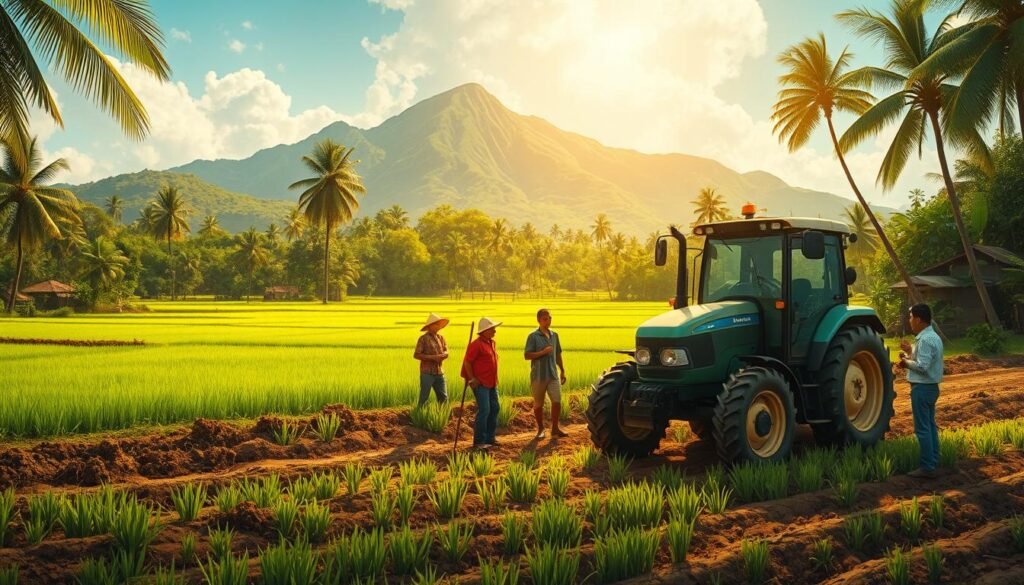
Mechanization and Equipment Advancements
One of the most significant changes has been the introduction of mechanized equipment. Tools like tractors, harvesters, and seed drills have replaced labor-intensive tasks. This shift has not only saved time but also increased yields across vast farming areas.
Modern irrigation systems have also played a crucial role. These systems ensure a consistent water supply, even during dry seasons. By reducing dependency on rainfall, farmers can maintain productivity year-round.
Innovative Crop Management Strategies
Precision agriculture is another key advancement. Farmers now use technology to monitor soil health, apply fertilizers strategically, and manage resources efficiently. This approach minimizes waste and maximizes output.
Crop rotation and intercropping have also gained popularity. These methods improve soil fertility and reduce the risk of pests. By adopting these strategies, farmers can maintain sustainable practices while boosting productivity.
These American techniques have not only streamlined farming operations but also ensured long-term sustainability. The integration of technology and innovative strategies continues to drive progress in Philippine agriculture.
Innovative Agricultural Methods from America
Innovative farming methods from the U.S. have revolutionized global practices, particularly in the Philippines. These advancements focus on technological development and the expertise of the person behind the operations. By integrating cutting-edge tools and strategies, farmers have achieved higher efficiency and sustainability.
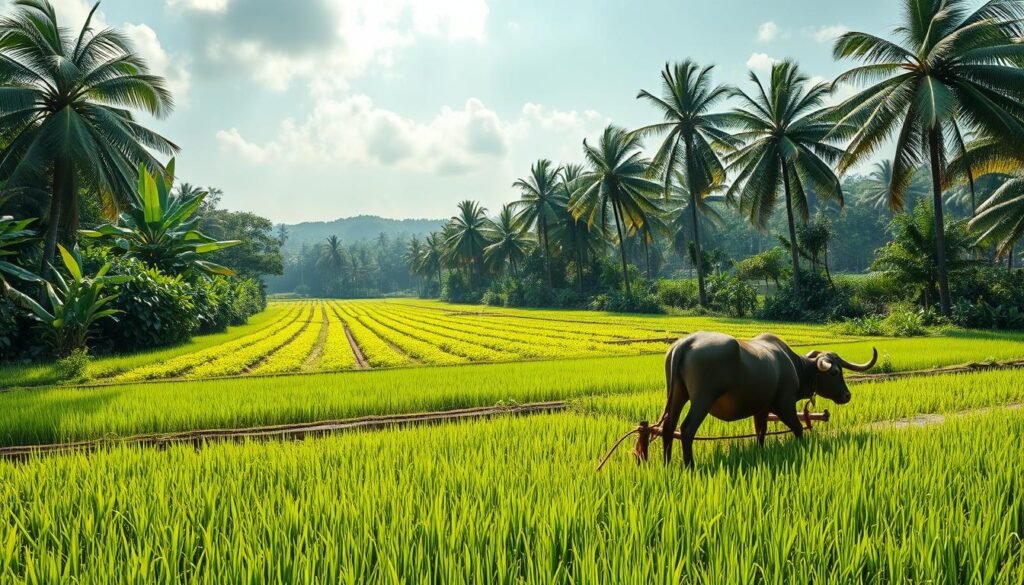
One of the most impactful innovations is precision agriculture. This method uses sensors, AI, and data analytics to optimize resource use. Farmers can monitor soil health, apply fertilizers strategically, and reduce waste. Such practices not only improve crop quality but also ensure long-term sustainability.
Another significant advancement is sustainable animal management. Techniques like rotational grazing and feed optimization have enhanced livestock health and productivity. These methods minimize environmental impact while maximizing output, benefiting both farmers and the ecosystem.
Here’s a comparison of traditional and modern farming practices:
| Aspect | Traditional Methods | Modern Techniques |
|---|---|---|
| Resource Use | High waste | Optimized |
| Livestock Management | Manual | Technology-driven |
| Efficiency | Low | High |
The adoption of these methods has transformed farming in the Philippines. By leveraging American innovations, farmers are ensuring food security and economic growth. For more insights into the historical context of these changes, visit this resource.
Impact on Local Farming Communities
The adoption of American farming methods has brought significant changes to local communities in the Philippines. These modern systems have not only improved crop yields but also strengthened the economic foundation of rural areas.
Recent research highlights the positive outcomes of these innovations. For example, farmers using advanced irrigation systems have reported a 30% increase in productivity. This result has led to higher incomes and better living standards for many families.

Beyond economic benefits, these systems have enhanced community resilience. Farmers are now better equipped to handle challenges like droughts and pests. This adaptability ensures food security and stability for entire regions.
Here are some key improvements observed in local communities:
- Increased crop yields due to efficient systems.
- Higher incomes from improved farming results.
- Greater access to education and healthcare.
- Stronger community networks and collaboration.
As one farmer shared,
“The new methods have changed our lives. We can now provide for our families and plan for the future.”
These advancements are not just about technology. They represent a shift toward sustainable and inclusive growth. By adopting these systems, Filipino communities are building a brighter future.
Technological Integration in Modern Filipino Farming
The Philippines is embracing cutting-edge technology to revolutionize its farming practices. Over the years, the adoption of digital and biotechnological tools has transformed the agricultural landscape. These innovations are not only boosting productivity but also ensuring sustainability for future generations.
Digital Tools for Farm Management
Farmers are now using advanced software to enhance decision-making. Tools like precision agriculture platforms provide real-time data on soil health, weather, and crop conditions. This allows farmers to optimize resource use and reduce waste.
For example, Project SARAi uses satellite imagery and drones to monitor crop health. This technology helps farmers detect issues early, ensuring healthier yields. Such tools are becoming essential in modern farming practices.
Biotechnological Breakthroughs
Biotechnology is also playing a crucial role in improving crop yields. Researchers are developing genetically modified crops that are more resistant to pests and diseases. These advancements reduce the need for chemical pesticides, promoting eco-friendly farming.
In Bataan, local innovations have cut fertilizer use by up to 70%. This not only saves costs but also minimizes environmental impact. Biotechnological research is paving the way for more sustainable farming methods.
Globally, the Philippines is catching up with other countries in adopting these technologies. While South Korea has 52,000 hectares of greenhouse farming, the Philippines is gradually increasing its use of such systems. This progress highlights the transformative role of technology in agriculture.
- Digital tools enhance decision-making and resource optimization.
- Biotechnology improves crop resilience and sustainability.
- Global comparisons show the Philippines’ growing adoption of modern farming tech.
- Technology is key to increasing productivity and ensuring food security.
Economic Transformation Through Farming Innovation
Modern farming innovations are reshaping the economic landscape of the Philippines. By integrating advanced techniques, farmers are unlocking new opportunities for growth and development. These changes are not only improving productivity but also strengthening local economies.
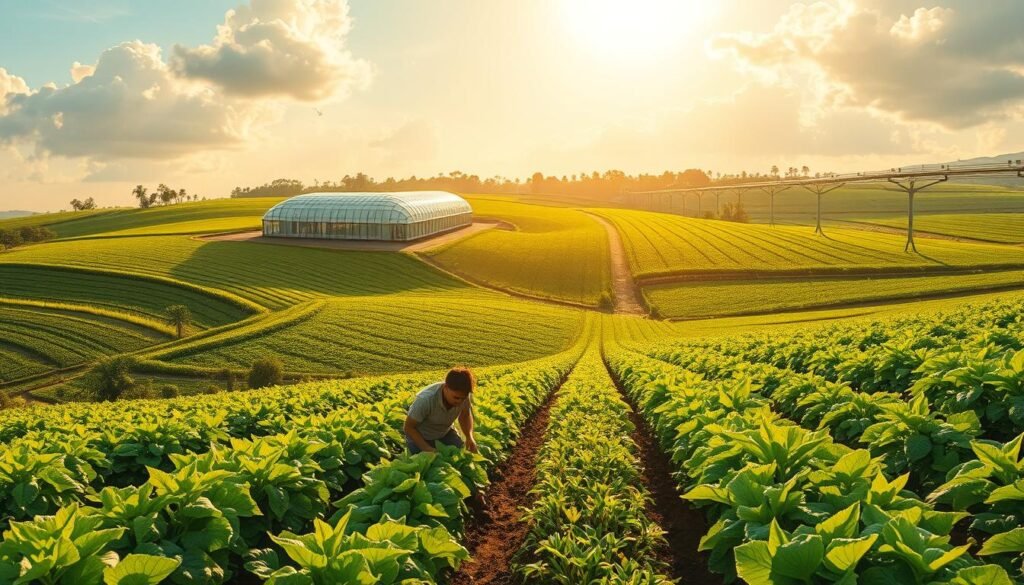
Improved land and water management have been key drivers of this transformation. Farmers are now using efficient irrigation systems to optimize water use. This ensures consistent crop yields, even during dry seasons. Better land management practices, such as crop rotation, have also enhanced soil fertility and reduced waste.
Boosting Local Market Access
Enhanced market access is another significant benefit of these innovations. Farmers can now reach broader consumer bases through improved infrastructure. Roads and transportation networks have been upgraded, making it easier to transport goods to urban centers.
Government and private initiatives are also playing a crucial role. Programs like ValueLinks 2.0 help integrate smallholder farmers into value chains. This ensures they receive fair prices for their produce, boosting their incomes and livelihoods.
Increasing National Productivity
National productivity has seen a sharp rise due to these advancements. Farmers using modern techniques report up to 30% higher yields. This increase in output has strengthened the country’s food security and reduced dependency on imports.
Here’s a comparison of traditional and modern farming impacts:
| Aspect | Traditional Methods | Modern Techniques |
|---|---|---|
| Yields | Low | High |
| Resource Use | Inefficient | Optimized |
| Market Access | Limited | Expanded |
These changes are creating a ripple effect across the economy. As one farmer noted,
“With these new methods, we can now plan for the future and provide for our families.”
The integration of modern farming practices is not just about technology. It represents a shift toward sustainable and inclusive growth, ensuring a brighter future for the Philippines.
Sustainable and Environmental Benefits of American Techniques
Sustainable practices from the U.S. are reshaping the ecological footprint of Philippine farming. By integrating advanced methods, farmers are not only boosting productivity but also protecting the environment. These techniques focus on conserving resources, improving soil health, and reducing carbon emissions.

One of the most significant benefits is the reduction of soil erosion. Practices like no-till farming and cover cropping have decreased erosion rates by up to 70%. This ensures that the soil remains fertile and productive for future generations.
Water and Soil Conservation Practices
Water conservation is another critical area where American techniques excel. Modern irrigation systems optimize water use, ensuring crops receive adequate hydration without waste. This is especially important in regions prone to drought.
Healthy soil is the foundation of sustainable farming. Crop rotation and intercropping improve soil fertility and reduce the need for chemical fertilizers. These methods also promote healthier plant growth, leading to higher yields.
As one farmer noted,
“These practices have transformed our land. We’re seeing better crops and healthier livestock.”
Renewable Energy Applications in Farming
Renewable energy is playing a growing role in Philippine agriculture. Solar panels and wind turbines are being used to power farms, reducing reliance on fossil fuels. This not only lowers costs but also minimizes the carbon footprint of farming operations.
For livestock farmers, renewable energy offers additional benefits. Solar-powered water pumps and electric fencing improve efficiency while reducing environmental impact. These innovations are helping farmers achieve sustainability without compromising productivity.
Here’s a quick look at the benefits of renewable energy in farming:
- Reduced carbon emissions from energy use.
- Lower operational costs for farmers.
- Improved efficiency in livestock management.
- Enhanced sustainability for future generations.
By adopting these practices, the Philippines is building a more sustainable agricultural sector. For more insights into the historical context of these changes, visit this resource.
Case Studies on U.S.-Inspired Farming Programs and Projects
Government initiatives inspired by American farming methods are transforming rural communities. These programs have introduced new techniques and policy frameworks that are reshaping agriculture in the Philippines. By focusing on practical solutions, these projects are improving the livelihoods of farmers and boosting productivity.

Success Stories from Government Initiatives
One notable example is the adoption of precision agriculture in Brazil. Inspired by U.S. methods, this approach uses technology to optimize resource use. Farmers in the Cerrado region have seen significant improvements in soybean production. This success story highlights the importance of collaboration and new technologies in modern farming.
In Ethiopia, a government-led initiative introduced modern irrigation systems. These systems, inspired by American practices, have increased crop yields by up to 40%. The project has also provided training for farmers, ensuring sustainable implementation. Such initiatives demonstrate the transformative power of policy changes and targeted support.
Here are some key outcomes of these programs:
- Increased crop yields through new farming techniques.
- Improved livelihoods for farmers due to better policy frameworks.
- Enhanced resilience to climate challenges.
- Stronger collaboration between governments and local communities.
As one farmer noted,
“These programs have given us the tools to succeed. We’re now able to provide for our families and plan for the future.”
For more insights into the impact of U.S.-inspired agricultural practices, visit this resource. These case studies highlight the potential of new approaches to drive progress and ensure food security for future generations.
Enhancing Crop and Livestock Production
The integration of advanced farming techniques has significantly boosted crop and livestock production in the Philippines. By adopting modern practices, farmers have achieved higher yields and improved the quality of their products. This transformation is driven by technological advancements and innovative strategies.
One of the key areas of improvement is in crop production. For example, the cultivation of wheat has seen a remarkable increase in yields. Modern irrigation systems and precision farming methods have optimized resource use, ensuring consistent output even in challenging conditions.
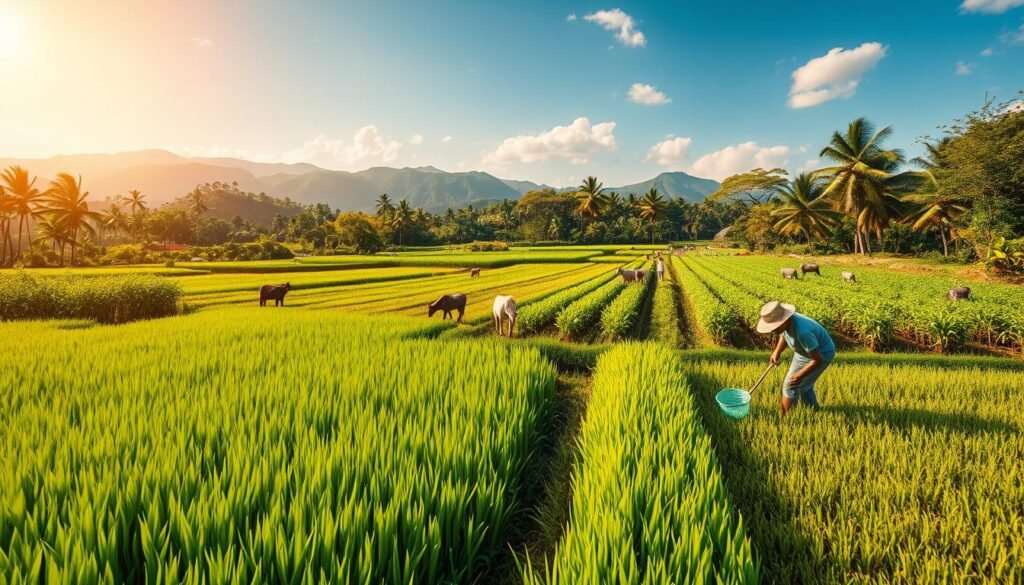
Livestock production has also benefited from these advancements. Farmers are now using better breeding techniques and feed management systems. This has led to healthier animals and higher productivity levels. Integrated systems that combine crop and livestock management are becoming increasingly popular, offering optimal outcomes for both sectors.
Here’s a comparison of traditional and modern production methods:
| Aspect | Traditional Methods | Modern Techniques |
|---|---|---|
| Crop Yields | Low | High |
| Livestock Health | Manual Care | Technology-Driven |
| Resource Use | Inefficient | Optimized |
These improvements are not just about higher yields. They also contribute to broader economic benefits and rural empowerment. By adopting these methods, farmers are ensuring food security and sustainable growth for future generations.
As one farmer noted,
“The new techniques have changed everything. We’re now able to produce more and provide for our families.”
The integration of advanced practices is reshaping the agricultural landscape in the Philippines. It highlights the importance of innovation in achieving long-term success and stability.
Advancements in Water Management and Irrigation Systems
Water management has become a cornerstone of sustainable farming in the Philippines, ensuring resilience against changing climate conditions. Modern irrigation systems and techniques are transforming the way farmers manage water resources, making farming more efficient and eco-friendly.
Modern Irrigation Systems and Techniques
One of the most significant advancements is the adoption of precision irrigation. This practice uses technology to deliver water directly to the roots of plants, minimizing waste. Systems like drip irrigation and sprinklers ensure that crops receive the right amount of water, even during dry spells.
Another innovative approach is the use of soil moisture sensors. These devices monitor soil conditions in real-time, allowing farmers to adjust irrigation schedules based on actual needs. This not only conserves water but also improves crop yields.
Here are some key benefits of modern irrigation systems:
- Reduced water usage through efficient practices.
- Improved crop yields and quality.
- Enhanced resilience to climate variability.
- Better protection of the environment by reducing runoff and soil erosion.
As one farmer shared,
“The new irrigation systems have changed the way we farm. We’re saving water and growing healthier crops.”
These advancements are not just about technology. They represent a shift toward sustainable and climate-smart farming. By adopting these practices, Filipino farmers are ensuring food security and protecting the environment for future generations.
Policy Support and Rural Infrastructure Developments
Government policies and rural infrastructure investments are key drivers of agricultural modernization in the Philippines. These initiatives focus on enhancing productivity, improving management frameworks, and fostering sustainable growth. By addressing critical needs like road networks and market access, these efforts are transforming rural communities.
One notable example is the USDA’s $6.3 billion investment in rural and Tribal communities across 44 states. Similar projects in the Philippines have improved irrigation systems and transportation networks. These developments ensure farmers can transport goods efficiently, reducing post-harvest losses and increasing incomes.
Enhanced management practices are also a priority. Programs like the Electric Infrastructure Loan and Loan Guarantee Program have funded smart grid technologies, benefiting thousands of consumers. In the Philippines, such innovations are helping farmers optimize resource use and reduce costs.
Here are some key outcomes of these initiatives:
- Increased productivity through better infrastructure.
- Improved management of resources and supply chains.
- Sustainable growth in rural economies.
- Higher incomes for farmers and stronger market access.
As one farmer shared,
“The new roads and irrigation systems have made a huge difference. We can now sell our produce faster and at better prices.”
These efforts highlight the importance of policy support in achieving long-term agricultural success. By investing in rural infrastructure, the Philippines is ensuring food security and economic stability for future generations.
Digital and Biotechnological Innovations in Agriculture
Digital and biotechnological advancements are revolutionizing farming practices in the Philippines. These innovations are introducing a variety of tools and techniques that optimize operations and enhance productivity. From precision irrigation systems to AI-driven platforms, modern farming is becoming more efficient and sustainable.
One of the most impactful changes is the use of digital platforms for farm management. Tools like CropWizard provide real-time data on soil health, weather conditions, and crop performance. This allows farmers to make informed decisions, reducing waste and improving yields. Such platforms are transforming how farmers approach their daily operations.
Biotechnological innovations are also playing a crucial role. Researchers are developing genetically modified crops that are more resistant to pests and diseases. These advancements not only increase crop resilience but also reduce the need for chemical inputs. This variety of biotechnological solutions is helping farmers achieve higher productivity while protecting the environment.
Precision irrigation is another game-changer. Systems like drip irrigation and soil moisture sensors ensure water is used efficiently. This is especially important in regions prone to drought. By optimizing water use, farmers can maintain consistent yields even in challenging conditions.
Here’s a quick look at the benefits of these innovations:
- Improved resource management through digital tools.
- Enhanced crop resilience with biotechnological solutions.
- Efficient water use with precision irrigation systems.
- Increased productivity and sustainability in farming operations.
As one farmer noted,
“These new tools have made farming easier and more profitable. We’re growing healthier crops and using fewer resources.”
For more insights into how digital agriculture is transforming farming, visit this resource. These innovations are not just about technology; they represent a shift toward smarter, more sustainable farming practices.
Comparative Analysis of Past and Present Practices
The evolution of farming practices in the Philippines reflects a blend of tradition and innovation. Over the years, the effect of historical methods has shaped the way modern techniques are implemented today. This section explores the amount of change observed and how traditional market dynamics have evolved with technological advancements.
Lessons from Historical Methods
Traditional farming practices, such as crop rotation and intercropping, have left a lasting effect on modern agriculture. These methods, once reliant on manual labor, have been adapted to optimize resource use. For example, the amount of water and fertilizer required has significantly decreased with the introduction of precision farming tools.
Historically, the market was driven by local trade and subsistence farming. Today, global demand and advanced supply chains have transformed the market landscape. Farmers now have access to broader networks, ensuring better prices and increased productivity.
Here’s a comparison of past and present practices:
| Aspect | Historical Methods | Modern Techniques |
|---|---|---|
| Resource Use | High | Optimized |
| Market Access | Local | Global |
| Productivity | Low | High |
As one farmer noted,
“The lessons from the past have guided us in adopting smarter practices. We’re now more efficient and sustainable.”
For more insights into the effect of these changes on sustainability, visit this resource. The integration of historical wisdom with modern innovation continues to drive progress in Philippine agriculture.
Challenges, Solutions, and Future Prospects
The agricultural sector in the Philippines faces a unique set of challenges as it transitions to modern practices. While advanced techniques promise higher productivity, their implementation is not without hurdles. From outdated equipment to inefficient processes, farmers must navigate a complex landscape to achieve sustainable growth.
Addressing Implementation Challenges
One of the primary obstacles is the lack of modern equipment. Many farmers still rely on traditional tools, which limit their ability to increase yields. For example, manual irrigation systems often lead to water waste, while outdated machinery slows down production. Addressing these issues requires significant investment in infrastructure and training.
Another challenge is the high cost of inputs. Fertilizer prices have risen by over 60% in recent years, putting financial strain on farmers. This forces many to prioritize short-term survival over long-term growth. Solutions like government subsidies and cooperative farming models can help mitigate these costs.
Here’s a breakdown of key challenges and potential solutions:
| Challenge | Solution |
|---|---|
| Outdated equipment | Invest in modern machinery and training programs |
| High input costs | Provide subsidies and promote cooperative farming |
| Water inefficiency | Adopt precision irrigation systems |
Vision for Future Agricultural Growth
Despite these challenges, the future of farming in the Philippines looks promising. Innovations like precision agriculture and biotechnology are paving the way for sustainable agricultural production. For instance, soil moisture sensors and AI-driven platforms are helping farmers optimize resource use and increase yields.
Government initiatives are also playing a crucial role. Programs aimed at improving rural infrastructure and providing financial support are empowering farmers to adopt modern practices. As one farmer noted,
“With the right tools and support, we can overcome these challenges and build a brighter future for our communities.”
Looking ahead, the integration of renewable energy and digital tools will further revolutionize the sector. Solar-powered irrigation systems and smart farming platforms are just a few examples of how technology can drive efficiency and sustainability. For more insights on overcoming agricultural challenges, visit this resource.
By addressing these challenges and embracing innovative solutions, the Philippines can achieve robust growth in its agricultural sector. This will not only ensure food security but also create opportunities for rural communities to thrive.
Conclusion
The journey of agricultural innovation in the Philippines highlights the transformative power of modern techniques. Over the years, the integration of American methods has significantly boosted production numbers, ensuring food security and economic growth. From advanced irrigation systems to precision farming, these practices have reshaped the sector.
One of the most notable outcomes is the enhanced quality of fruit and other crops. Farmers now achieve higher yields while minimizing environmental impact. This progress is a testament to the collaborative efforts in agricultural investment and policy support, which have been crucial in driving these advancements.
Looking ahead, continuous innovation and adaptation will be essential. By embracing sustainable practices and leveraging technology, the Philippines can secure a prosperous future for its farming communities. For more insights into these collaborative efforts, visit this resource.
FAQ
How have American farming methods influenced the Philippines?
American farming methods have introduced advanced equipment, crop management strategies, and sustainable practices, significantly improving productivity and efficiency in the Philippines.
What are some key technological advancements in Filipino farming?
Filipino farming has adopted digital tools for farm management, biotechnological breakthroughs, and modern irrigation systems, enhancing both crop and livestock production.
How has U.S.-inspired farming impacted local communities?
U.S.-inspired farming has boosted local market access, increased national productivity, and improved livelihoods through innovative and sustainable practices.
What environmental benefits do American techniques offer?
American techniques promote water and soil conservation, renewable energy use, and sustainable farming, reducing environmental impact and preserving resources.
Are there successful examples of U.S.-inspired farming programs?
Yes, government initiatives and projects have led to success stories, showcasing improved yields, economic growth, and community development through these methods.
What challenges do Filipino farmers face in adopting these techniques?
Challenges include limited access to advanced equipment, high implementation costs, and the need for training and policy support to ensure widespread adoption.
How do modern irrigation systems benefit Filipino agriculture?
Modern irrigation systems optimize water use, increase crop yields, and reduce water waste, making farming more efficient and sustainable in the Philippines.
What role does policy play in supporting agricultural innovation?
Policies provide funding, infrastructure development, and training programs, enabling farmers to adopt new technologies and practices effectively.
How has biotechnology transformed farming in the Philippines?
Biotechnology has introduced disease-resistant crops, improved livestock breeds, and enhanced food security, contributing to the overall growth of the agricultural sector.
What is the future outlook for farming in the Philippines?
The future looks promising with continued technological integration, sustainable practices, and policy support, aiming for long-term growth and resilience in the agricultural sector.
Source Links
- Philippines Agricultural Technology
- Agricultural Trade Between the Philippines and the US: Status, Issues and Prospects
- American, Filipino Firms Explore Partnerships in First U.S. Agricultural Technology Trade Mission to the Philippines
- Fact Sheet Philippines – Women in agriculture, environment and rural production
- United States and Philippines Cooperation Highlighted at U.S.-Philippines Food Security Dialogue
- History – Official Portal of the Department of Agriculture
- Agriculture in the Philippines
- Agricultural mechanization in the Philippines, Part I: Brief history
- Agriculture in the United States
- Overview
- Climate-Smart Agriculture
- Top 13 Innovations in Agriculture/Farming in 2023
- Nine projects spearheading nature-positive agricultural innovations – Global Resilience Partnership
- What is regenerative agriculture?
- Effects of Urban Smart Farming on Local Economy and Food Production in Urban Areas in African Cities
- Food Security & Agriculture – Global Communities
- Technology-based farms key to attracting new generation of farmers — DA chief – Official Portal of the Department of Agriculture
- Empower farmers through tech and connectivity
- Digitalisation Boosts Philippine Agriculture – OpenGov Asia
- Agricultural-based economic development
- Global Agricultural Development – Investing in Transformation and Innovation
- What Is Sustainable Agriculture?
- Sustainable Agriculture | Learn Science at Scitable
- Urban Agriculture Case Studies in Central Texas: From the Ground to the Rooftop
- Farmer-to-Farmer Case Study Series | REACCH
- Project on enhancing crop and livestock production and productivity in new lands through the adoption of innovative climate resilient agricultural practices and technologies
- Frontiers | Crop–livestock-integrated farming system: a strategy to achieve synergy between agricultural production, nutritional security, and environmental sustainability
- Agricultural Water Management: Smart Methods & Technologies
- Economic valuation of water resources in agriculture
- The Use and Management of Agricultural Irrigation Systems and Technologies
- USDA Invests $6.3 Billion to Strengthen Rural Infrastructure and Create Good-Paying Jobs in 44 States
- Agriculture and Infrastructure: What’s the Connection?
- AIFARMS researchers showcase groundbreaking AgTech and AI innovations | College of Agricultural, Consumer & Environmental Sciences
- Digital Agriculture Innovations | CCARDESA
- AI-Driven Innovations in Agriculture / Alabama Agricultural Experiment Station
- Evolutionary change in agriculture: the past, present and future
- Comparative Analysis of Agricultural Assets, Incomes and Food Security of Rural Households in Ghana, Senegal and Liberia
- Chapter 7. Globalization and the traditional role of agriculture[124]
- Top 7 Ag Issues 2024: Challenges in Modern Agriculture | Verdesian
- Agriculture Problems Faced By Farmers And Their Solutions
- The Future Challenges of Food and Agriculture: An Integrated Analysis of Trends and Solutions
- Conclusions (Synthesis) | Creating a Sustainable Food Future
- Conclusions
- Promoting Sustainable Agriculture Practices: Conclusion – fundsforNGOs – Grants and Resources for Sustainability

